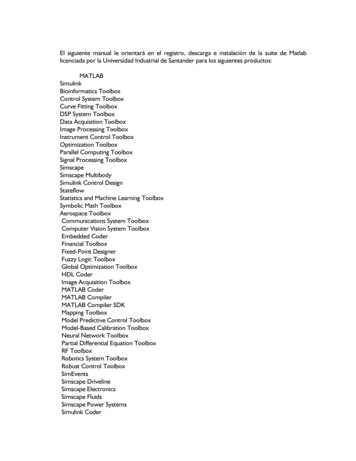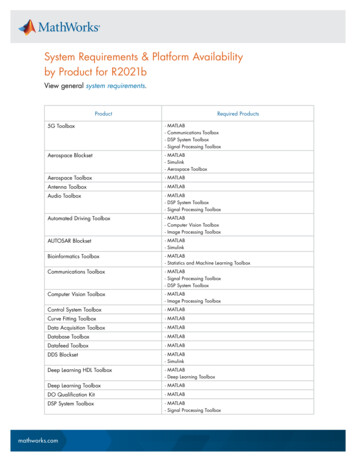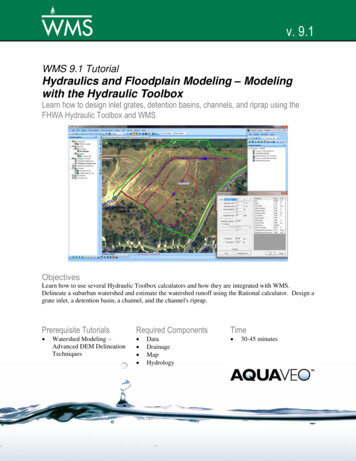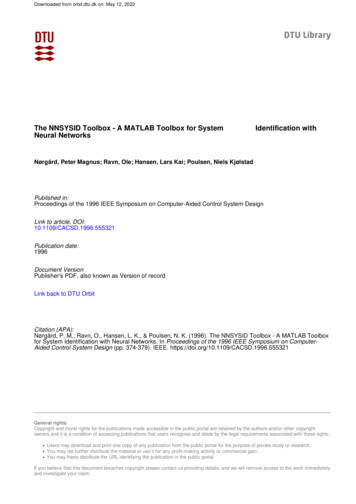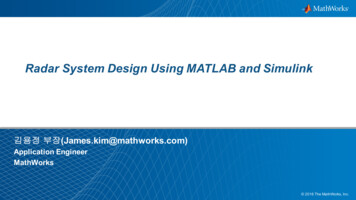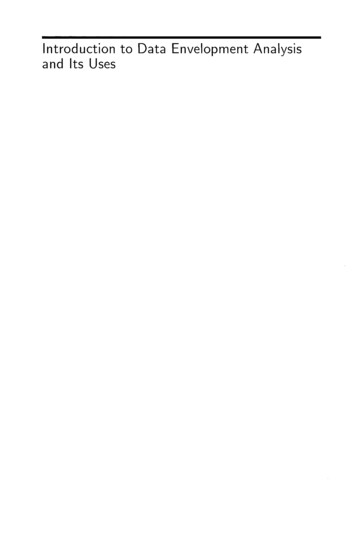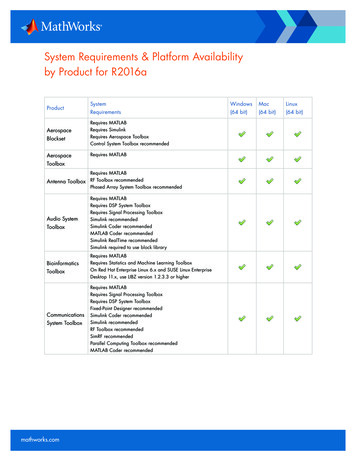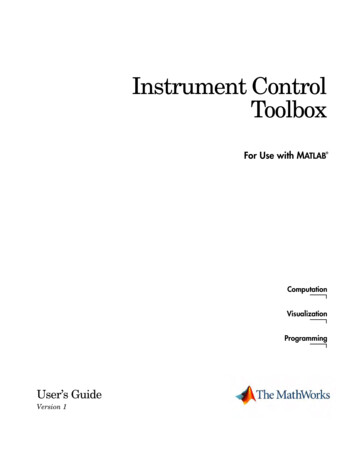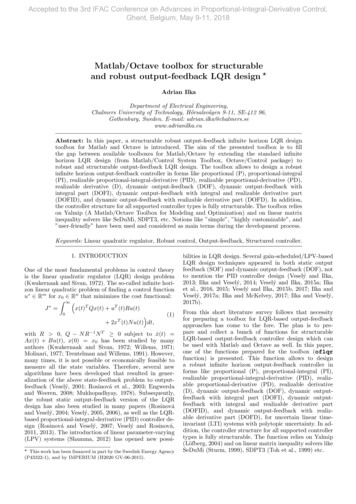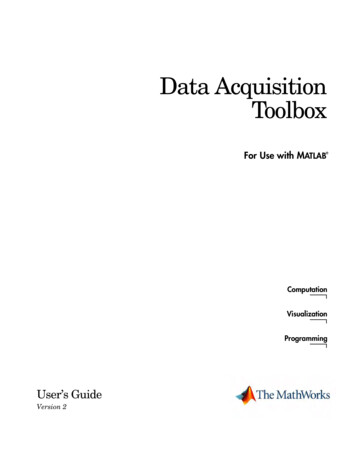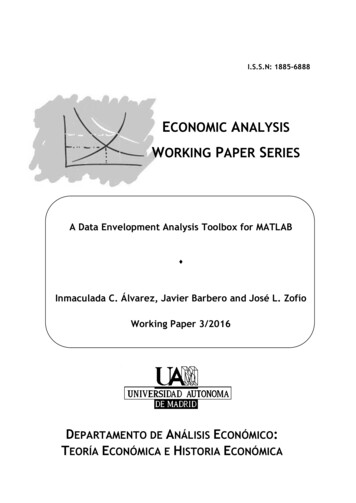
Transcription
I.S.S.N: 1885-6888ECONOMIC ANALYSISWORKING PAPER SERIESA Data Envelopment Analysis Toolbox for MATLAB Inmaculada C. Álvarez, Javier Barbero and José L. ZofíoWorking Paper 3/2016DEPARTAMENTO DE ANÁLISIS ECONÓMICO:TEORÍA ECONÓMICA E HISTORIA ECONÓMICA
A Data Envelopment Analysis Toolbox for MATLABInmaculada C. ÁlvarezJavier BarberoJosé L. Zofı́oUniversidad Autónoma de MadridAbstractData Envelopment Analysis Toolbox is a new package for MATLAB that includesfunctions to calculate the main DEA models. The package includes code for the standard additive and radial input and output measures, allowing for constant and variablereturns to scale, as well as recent developments related to the directional distance function, and including both desirable and undesirable outputs when measuring efficiencyand productivity; i.e., Malmquist and Malmquist-Luenberger indices. Bootstrapping toperform statistical analysis is also included. This paper describes the methodology andimplementation of the functions and reports numerical results with well-known examplesto illustrate their use.Keywords: Data Envelopment Analysis, distance functions, technical efficiency, MATLABJEL codes: D20, 24, C44 .Affiliation:Inmaculada C.Álvarez, Javier Barbero, José L. Zofı́oDepartment of EconomicsUniversidad Autónoma de Madrid28049 Madrid, SpainE-mail: inmaculada.alvarez@uam.es, javier.barbero@uam.es, jose.zofio@uam.esURL: http://www.deatoolbox.com/
2A Data Envelopment Analysis Toolbox for MATLAB1. IntroductionData Envelopment Analysis, DEA, has grown in importance over the past decades due to increase in the availability of data related to the performance of Decision Making Units, DMUs,regardless their market, governmental, or non-for-profit orientation. Basic DEA methods areincluded in some standard software packages used by econometricians (e.g., Stata, StataCorp(2015) with the user-written command by Ji and Lee (2010); LIMDEP, Econometric Software(2009)); available in dedicated non-commercial software accompanying academic handbooks–Cooper, Seiford, and Tone (2007), Wilson (2008), Bogetoft and Otto (2011) (these lattertwo implemented in R); commercial software–including trials versions, Emrouznejad and Cabanda (2014); free-ware programs–Sheel (2000); and even tutorials for spreadsheets, Shermanand Zhu (2006). Earlier versions of these programs have been reviewed, among others, byHollingsworth (2004) and Barr (2004), and there are continuous proposals expanding theseoptions. While these software packages implement the main DEA models, there is a lackof a full set of functions for MATLAB (The MathWorks, Inc. 2015), including some recenttheoretical contributions that are missed in the existing software.The Data Envelopment Analysis Toolbox introduces such set of functions, covering a widerange of efficiency and productivity models, and reporting numerical results based on classicalexamples presented in the literature. Data Envelopment Analysis Toolbox is available asfree software, under the GNU General Public License version 3, and can be downloadedfrom http://www.deatoolbox.com, with all the supplementary material (data, examples andsource code) to replicate all the results presented in this paper. The toolbox is also hosted onan open source repository on GitHub.1The paper is organized as follows. The following section presents the data structures characterizing the production possibility sets, the structure of the functions, results, etc. Section 3covers the standard DEA models introduced by Charnes, Cooper, and Rhodes (1978) andBanker, Charnes, and Cooper (1984) corresponding to the radial input and output efficiencymeasures, allowing for constant and variable returns to scale, as well as newer proposals basedon the flexible directional distance function. The non-oriented additive model is also presentedas well as the super-efficiency model for all the previous efficiency measures. Malmquist productivity indices and their decomposition into efficiency change and technical change areshown in section 4, while section 5 deals with the measurement of economic efficiency, andits decomposition into technical and allocative terms. Section 6 is devoted to the measurement of efficiency with undesirable outputs, most notably environmental efficiency, followedby Section 7 presenting the Malmquist-Luenberger index. Statistical analyses and hypotheses testing using bootstrapping techniques are presented in Section 8. Advanced options,including displaying and exporting results can be found in Section 9. Section 10 concludes.2. Data structuresData Envelopment Analysis measures productive and economic performance of a set of j 1, 2, . . . , n observed DMUs (firms, activities, countries, individuals, etc.). These observationstransform a vector of i 1, 2, . . . , m inputs x Rm into a vector of i 1, 2, . . . , s outputsy Rs using the technology represented by the following constant returns to scale production possibility set: Pcrs {(x, y) x Xλ, y 6 Y λ, λ 0}, where X (x)j Rs n , Y 1The address of the repository is https://github.com/javierbarbero/DEAMATLAB
Inmaculada C. Álvarez, Javier Barbero, José L. Zofı́o3(y)j Rm n and λ (λ1 , . . . , λn )T is a semipositive vector.Data are managed as regular MATLAB vectors and matrices, constituting the inputs of theestimation functions. All estimation functions return a structure deaout that contains fieldswith the estimation results as well as the input of the estimation function. Fields can beaccessed directly using the dot notation and the whole structure can be used as an input toother functions that print or export results (e.g., deadisp).Some of the fields of the deaout structure are the following:2 X, Y and Yu: contain the inputs, outputs and undesirable outputs variables, respectively. n and neval: number of DMUs, and number of evaluated DMUs. m, s and r: number of inputs, outputs and undesirable outputs. model, orient, rts: strings containing the model type, the orientation, and the returnsto scale assumption. eff: computed efficiency measure. slackX, slackY, slackYu: computed input, output and undesirable output slacks. names: names of the DMUs.3. Basic DEA models3.1. Radial input oriented model: Constant and variable returns to scaleBased on the data matrix (X, Y ), we measure the input oriented efficiency of each observationo by solving n times the following linear programming problem–known as the ccr model:3minθ,λθ(1)subject toθxo XλY λ yoλ 0.The optimal solution to this program—characterizing a technology with constant returns to . The constraints require the observation (θscale, is denoted by θcrscrs xo , yo ) to belong toPcrs , while the objective seeks the minimum θcrs that reduces the input vector xo radially to θcrs xo while remaining in Pcrs . A feasible solution signaling radial efficiency is θcrs 1.2For a full list see the help of the function typing help deaout in MATLAB.This program corresponds to the so-called “envelopment form” of the formulation introduced by Charneset al. (1978). Correspondences with the dual approaches (“multipliers form”) can be found in Cooper et al.(2007).3
4A Data Envelopment Analysis Toolbox for MATLAB Therefore if θcrs 1, the observation is radially inefficient and (λX, λY ) outperforms (xo , yo ).With regard to this property, we define the additional input excesses and outputs shortfalls by x Xλ,the following slack vectors: s Rm and s Rs , respectively. Therefore: s θcrsoand s Y λ yo with s 0 and s 0 for any feasible solution (θ, λ).To obtain the possible input excesses and output shortfalls, the following second stage program that incorporates the optimal value θcrsand corrects radial inefficiency is solved:maxλ, s , s ω es es (2)subject to s θcrsxo Xλs Y λ yoλ 0, s 0, s 0,where e (1, . . . , 1)T so es i 1 siPmand es Ps i 1 si . , λ , s , s )As a result, an observation is technically efficient if the optimal solution (θcrs of the two above programs satisfy θcrs 1, s 0, and s 0, so no equiproportionalcontraction of inputs, and individual inputs reductions and outputs increases are possible(Pareto-Koopmans Efficiency).4The measurement of technical efficiency assuming variables returns to scale as introduced byBanker et al. (1984)–known as the bcc model, considers the following production possibilityset Pvrs {(x, y) x Xλ, y 6 Y λ, eλ 1, λP 0.}. Therefore, the only difference withthe crs model is the adjunction of the condition nj 1 λj 1. Calculating the vrs efficiency,along with the subsequent second stage program analogous to (2), yields the corresponding , λ , s , s ). As before, an observation is efficient with respect to theoptimal solution (θvrs vrs technology if the optimal solution of the two programs satisfy θvrs 1, s 0, and s 0.Finally, the scale efficiency of each observation is calculated as the ratio of the vrs to the /θ . As a result the radial technical efficiency of an observation cancrs scores: SE θcrsvrsbe decomposed into its variable returns to scale efficiency (“pure” technical efficiency, P T E) SE.and scale efficiency: T E θcrs P T E SE θvrsThe radial input oriented model can be computed in MATLAB using the dea(X, Y, .)function with the orient parameter set to io (input oriented). The returns to scale assumption can be specified by setting the rts parameter to crs (constant returns to scale; default)or vrs (variable returns to scale). Results are returned in a deaout structure and can beaccessed directly (see Section 2) or displayed using the deadisp function.5 load 'deadataFLS'4It is possible to solve both programs in a single stage formulation employing a “non-Archimedian” infinitesimal constant , e.g., (Fried, Lovell, and Schmidt 1993, 140). However, this may result in computationalinaccuracies and erroneous results.5See Section 9.3 for advanced uses of the deadisp function. The example for the input, output, directionaland additive models corresponds to (Fried et al. 1993, 122).
Inmaculada C. Álvarez, Javier Barbero, José L. Zofı́o io dea(X, Y, 'orient', 'io'); deadisp(io);Data Envelopment Analysis (DEA)DMUs: 11Inputs: 2Outputs: 1Model: radialOrientation: io (Input oriented)Returns to scale: crs ---------------------------DMU X1 X2 Y Theta slackX1 slackX2 slackY -----------------1 5.0000 13.0000 12.0000 1.0000 0.0000 0.0000 0.0000 2 16.0000 12.0000 14.0000 0.6223 0.0000 0.0000 0.0000 3 16.0000 26.0000 25.0000 0.8199 0.0000 0.0000 0.0000 4 17.0000 15.0000 26.0000 1.0000 0.0000 0.0000 0.0000 5 18.0000 14.0000 8.0000 0.3104 0.0000 0.0000 0.0000 6 23.0000 6.0000 9.0000 0.5556 4.4444 0.0000 0.0000 7 25.0000 10.0000 27.0000 1.0000 0.0000 0.0000 0.0000 8 27.0000 22.0000 30.0000 0.7577 0.0000 0.0000 0.0000 9 37.0000 14.0000 31.0000 0.8201 1.6402 0.0000 0.0000 10 42.0000 25.0000 26.5000 0.5000 0.0000 0.0000 0.0000 11 5.0000 17.0000 12.0000 1.0000 0.0000 4.0000 0.0000 ----------------- io vrs dea(X, Y, 'orient', 'io', 'rts', 'vrs'); deadisp(io vrs);Data Envelopment Analysis (DEA)DMUs: 11Inputs: 2Outputs: 1Model: radialOrientation: io (Input oriented)Returns to scale: vrs ---------------------------DMU X1 X2 Y Theta slackX1 slackX2 slackY -----------------1 5.0000 13.0000 12.0000 1.0000 0.0000 0.0000 0.0000 2 16.0000 12.0000 14.0000 0.8700 0.0000 0.0000 0.0000 3 16.0000 26.0000 25.0000 1.0000 0.0000 0.0000 0.0000 4 17.0000 15.0000 26.0000 1.0000 0.0000 0.0000 0.0000 5
6A Data Envelopment Analysis Toolbox for MATLAB5 18.0000 14.0000 8.0000 0.7116 0.0000 0.0000 2.6984 6 23.0000 6.0000 9.0000 1.0000 0.0000 0.0000 0.0000 7 25.0000 10.0000 27.0000 1.0000 0.0000 0.0000 0.0000 8 27.0000 22.0000 30.0000 1.0000 0.0000 0.0000 0.0000 9 37.0000 14.0000 31.0000 1.0000 0.0000 0.0000 0.0000 10 42.0000 25.0000 26.5000 0.5000 0.0000 0.0000 0.0000 11 5.0000 17.0000 12.0000 1.0000 0.0000 4.0000 0.0000 -----------------The scale efficiency can be calculated using the deascaleeff(X, Y, .) function. Thefunction parameters are the same as those of the dea function, although the rts parameterspecified will be omitted since both are needed in order to compute scale efficiency. io scale deascale(X, Y, 'orient', 'io'); deadisp(io scale);Data Envelopment Analysis (DEA)DMUs: 11Inputs: 2Outputs: 1Model: radialOrientation: io (Input oriented)Returns to scale: scaleeff (Scale efficiency)--------------------------------DMU CRS VRS ScaleEff --------------------------------1 1.0000 1.0000 1.0000 2 0.6223 0.8700 0.7153 3 0.8199 1.0000 0.8199 4 1.0000 1.0000 1.0000 5 0.3104 0.7116 0.4361 6 0.5556 1.0000 0.5556 7 1.0000 1.0000 1.0000 8 0.7577 1.0000 0.7577 9 0.8201 1.0000 0.8201 10 0.5000 0.5000 1.0000 11 1.0000 1.0000 1.0000 ---------------------------------3.2. Radial output oriented model: Constant and variable returns to scaleIt is possible to measure the output oriented technical efficiency of each observation by solvingthe following linear program, counterpart to (1):
Inmaculada C. Álvarez, Javier Barbero, José L. Zofı́omaxφφ,λ7(3)subject toXλ xoφyo Y λλ 0.In this case, the optimal solution is denoted by φ crs with the constraints ensuring that(xo , φ crs yo ) belongs to Pcrs . Now the objective seeks the maximum φcrs that increasesthe output vector yo radially to φ crs yo while remaining in Pcrs . A feasible solution signalingradial efficiency is φ crs 1. Therefore if φ crs 1, the observation is radially inefficient and(λX, λY ) outperforms (xo , yo ). Again, there might be farther input excesses and outputsshortfalls, with: s xo Xλ, and s Y λ φ crs yo with s 0 and s 0 for any feasible solution (φ, λ). To calculate these slacks in a second stage, the corresponding programincorporating the optimal value φ crs is needed:maxλ, s , s ω es es (4)subject tos xo Xλs Y λ φ crs yoλ 0, s 0, s 0.Finally, it is also possible to calculate the technical efficiency with respect to Pvrs by solvingthe programs for the radial component andPits associated input and output slacks analogous to(3) and (4), but adding the vrs contraint nj 1 λj 1. If φ vrs 1 the observation is radiallyefficient, while it is technically efficient if s 0 and s 0 in the second stage. The scaleefficiency defines as SE φ vrs /φ crs and radial efficiency can be now decomposed into puretechnical efficiency, P T E, and scale efficiency: T E φ crs P T E SE φ vrs SE.The radial output oriented model is computed in MATLAB using the same dea(X, Y, .)function with the orient parameter set to oo (output oriented). Again, the returns to scaleassumption can be specified by setting the rts parameter to crs (constant returns to scale;default) or vrs (variable returns to scale). oo dea(X, Y, 'orient', 'oo'); deadisp(oo);Data Envelopment Analysis (DEA)DMUs: 11Inputs: 2Outputs: 1
8A Data Envelopment Analysis Toolbox for MATLABModel: radialOrientation: oo (Output oriented)Returns to scale: crs ---------------------------DMU X1 X2 Y Phi slackX1 slackX2 slackY -----------------1 5.0000 13.0000 12.0000 1.0000 0.0000 0.0000 0.0000 2 16.0000 12.0000 14.0000 1.6070 0.0000 0.0000 0.0000 3 16.0000 26.0000 25.0000 1.2197 0.0000 0.0000 0.0000 4 17.0000 15.0000 26.0000 1.0000 0.0000 0.0000 0.0000 5 18.0000 14.0000 8.0000 3.2220 0.0000 0.0000 0.0000 6 23.0000 6.0000 9.0000 1.8000 8.0000 0.0000 0.0000 7 25.0000 10.0000 27.0000 1.0000 0.0000 0.0000 0.0000 8 27.0000 22.0000 30.0000 1.3198 0.0000 0.0000 0.0000 9 37.0000 14.0000 31.0000 1.2194 2.0000 0.0000 0.0000 10 42.0000 25.0000 26.5000 2.0000 0.0000 0.0000 0.0000 11 5.0000 17.0000 12.0000 1.0000 0.0000 4.0000 0.0000 ----------------- oo vrs dea(X, Y, 'orient', 'oo', 'rts', 'vrs'); deadisp(oo vrs);Data Envelopment Analysis (DEA)DMUs: 11Inputs: 2Outputs: 1Model: radialOrientation: oo (Output oriented)Returns to scale: vrs ---------------------------DMU X1 X2 Y Phi slackX1 slackX2 slackY -----------------1 5.0000 13.0000 12.0000 1.0000 0.0000 0.0000 0.0000 2 16.0000 12.0000 14.0000 1.5075 0.0000 0.0000 0.0000 3 16.0000 26.0000 25.0000 1.0000 0.0000 0.0000 0.0000 4 17.0000 15.0000 26.0000 1.0000 0.0000 0.0000 0.0000 5 18.0000 14.0000 8.0000 3.2039 0.0000 0.0000 0.0000 6 23.0000 6.0000 9.0000 1.0000 0.0000 0.0000 0.0000 7 25.0000 10.0000 27.0000 1.0000 0.0000 0.0000 0.0000 8 27.0000 22.0000 30.0000 1.0000 0.0000 0.0000 0.0000 9 37.0000 14.0000 31.0000 1.0000 0.0000 0.0000 0.0000 10 42.0000 25.0000 26.5000 1.1698 5.0000 11.0000 0.0000 11 5.0000 17.0000 12.0000 1.0000 0.0000 4.0000 0.0000 ------------------
Inmaculada C. Álvarez, Javier Barbero, José L. Zofı́o9 oo scale deascale(X, Y, 'orient', 'oo'); deadisp(oo scale);Data Envelopment Analysis (DEA)DMUs: 11Inputs: 2Outputs: 1Model: radialOrientation: oo (Output oriented)Returns to scale: scaleeff (Scale efficiency)--------------------------------DMU CRS VRS ScaleEff --------------------------------1 1.0000 1.0000 1.0000 2 1.6070 1.5075 1.0660 3 1.2197 1.0000 1.2197 4 1.0000 1.0000 1.0000 5 3.2220 3.2039 1.0056 6 1.8000 1.0000 1.8000 7 1.0000 1.0000 1.0000 8 1.3198 1.0000 1.3198 9 1.2194 1.0000 1.2194 10 2.0000 1.1698 1.7097 11 1.0000 1.0000 1.0000 ---------------------------------3.3. The directional model: Constant and variable returns to scaleChambers, Chung, and Färe (1996) introduced a measure of efficiency that projects observation (xo , yo ) in a pre-assigned direction g gx , gy 6 0m s , gx Rm and gy Rs , in aproportion β. The associated linear program is:maxβ,λβ(5)subject toXλ xo βgx Y λ yo βgy λ 0. . Now β In this occasion the optimal solution to this program corresponds to βcrscrs 0 signals directional inefficiency. Therefore if βcrs 0, the observationis inefficient and g , y β g P(λX, λY ) outperforms (xo , yo ), with xo βcrs.Itis again possibleocrsxcrs y
10A Data Envelopment Analysis Toolbox for MATLABthat further input excesses and outputs shortfalls exist. The slacks corresponding to s xo βgx Xλ, and s Y λ yo βgy , with s 0 and s 0 for any feasible solution(β, λ). As a result, a second stage is once again needed to calculate these slacks. The next program incorporating the optimal value βcrsallows determination of these values:maxλ, s , s ω es es (6)subject tos xo βgx Xλs Y λ yo βgy λ 0, s 0, s 0.As in the input and output oriented models, one may also calculate technical efficiency withrespect toPPvrs . This requires solving equivalent programs to (5) and (6) adding the vrs 0 and s 0 and s 0, the observation is technicallycontraint nj 1 λj 1. If βvrs β efficient. Consequently, we now define scale efficiency as SE βcrsvrs and directionalefficiency is decomposed into pure technical efficiency, P T E, and the scale efficiency term: P T E SE β SE.T E βcrsvrsThe directional model is oriented both in the input and output dimensions, while the choiceof directional vector corresponds to the researcher. Customarily, to keep consistency with theradial models, the observed amounts of input and output set the direction: g gx , gy ( xo , yo ), coinciding with the generalized Farrell measure, Briec (1997). In this case it canbe shown that the directional model nests the input and output oriented models. Indeed, (0, y ), β φ 1.,gif gx , gy ( xo , 0), then β 1 θ , while if gx o yHowever, other choices are available; particulary gx , gy ( 1, 1) or the mean of thedata: gx , gy ( x̄o , ȳo ), which are neutral with respect to the orientation, as it doesnot use the individual weights corresponding to the observed amounts of inputs and outputs.6When deciding on the directional model, the researcher must declare whether the directioncorresponds to the observed input or outputs mixes, the unitary vectors, or her own choice ofdirectional vector. In this case she must introduce the directional input and output matrices.The directional model can be computed in MATLAB using the dea(X, Y, .) function withthe orient parameter set to ddf (directional). The input and output directions are specifiedin the Gx and Gy parameters as a matrix or as a scalar (usually, 0 or 1). If omitted, X and Ywill be used for Gx and Gy respectively. The returns to scale assumption can be specified bysetting the rts parameter to crs (constant returns to scale; default) or vrs (variable returnsto scale). ddf dea(X, Y, 'orient', 'ddf', 'Gx', X, 'Gy', Y); deadisp(ddf);Data Envelopment Analysis (DEA)6Other directions are possible, including elaborated transformations driven by the data as proposed byDaraio and Simar (2016), or those projecting observations to economic optima as introduced by Zofı́o, Pastor,and Aparicio (2013), e.g. maximum profit–as shown in section 5.
Inmaculada C. Álvarez, Javier Barbero, José L. Zofı́oDMUs: 11Inputs: 2Outputs: 1Model: radialOrientation: ddf (Directional distance function)Returns to scale: crs ---------------------------DMU X1 X2 Y Beta slackX1 slackX2 slackY -----------------1 5.0000 13.0000 12.0000 0.0000 0.0000 0.0000 0.0000 2 16.0000 12.0000 14.0000 0.2328 0.0000 0.0000 0.0000 3 16.0000 26.0000 25.0000 0.0990 0.0000 0.0000 0.0000 4 17.0000 15.0000 26.0000 0.0000 0.0000 0.0000 0.0000 5 18.0000 14.0000 8.0000 0.5263 0.0000 0.0000 0.0000 6 23.0000 6.0000 9.0000 0.2857 5.7143 0.0000 0.0000 7 25.0000 10.0000 27.0000 0.0000 0.0000 0.0000 0.0000 8 27.0000 22.0000 30.0000 0.1379 0.0000 0.0000 0.0000 9 37.0000 14.0000 31.0000 0.0988 1.8023 0.0000 0.0000 10 42.0000 25.0000 26.5000 0.3333 0.0000 0.0000 0.0000 11 5.0000 17.0000 12.0000 0.0000 0.0000 4.0000 0.0000 ----------------- ddf vrs dea(X, Y, 'orient', 'ddf', 'rts', 'vrs', 'Gx', X, 'Gy', Y); deadisp(ddf vrs);Data Envelopment Analysis (DEA)DMUs: 11Inputs: 2Outputs: 1Model: radialOrientation: ddf (Directional distance function)Returns to scale: vrs ---------------------------DMU X1 X2 Y Beta slackX1 slackX2 slackY -----------------1 5.0000 13.0000 12.0000 0.0000 0.0000 0.0000 0.0000 2 16.0000 12.0000 14.0000 0.1076 0.0000 0.0000 0.0000 3 16.0000 26.0000 25.0000 0.0000 0.0000 0.0000 0.0000 4 17.0000 15.0000 26.0000 0.0000 0.0000 0.0000 0.0000 5 18.0000 14.0000 8.0000 0.2884 0.0000 0.0000 0.3915 6 23.0000 6.0000 9.0000 0.0000 0.0000 0.0000 0.0000 7 25.0000 10.0000 27.0000 0.0000 0.0000 0.0000 0.0000 8 27.0000 22.0000 30.0000 0.0000 0.0000 0.0000 0.0000 9 37.0000 14.0000 31.0000 0.0000 0.0000 0.0000 0.0000 11
12A Data Envelopment Analysis Toolbox for MATLAB10 42.0000 25.0000 26.5000 0.1629 0.0000 5.4560 0.0000 11 5.0000 17.0000 12.0000 0.0000 0.0000 4.0000 0.0000 ----------------- ddf scale deascale(X, Y, 'orient', 'ddf', 'Gx', X, 'Gy', Y); deadisp(ddf scale);Data Envelopment Analysis (DEA)DMUs: 11Inputs: 2Outputs: 1Model: radialOrientation: ddf (Directional distance function)Returns to scale: scaleeff (Scale efficiency)--------------------------------DMU CRS VRS ScaleEff --------------------------------1 0.0000 0.0000 0.0000 2 0.2328 0.1076 0.1252 3 0.0990 0.0000 0.0990 4 0.0000 0.0000 0.0000 5 0.5263 0.2884 0.2379 6 0.2857 0.0000 0.2857 7 0.0000 0.0000 0.0000 8 0.1379 0.0000 0.1379 9 0.0988 0.0000 0.0988 10 0.3333 0.1629 0.1705 11 0.0000 0.0000 0.0000 ---------------------------------
Inmaculada C. Álvarez, Javier Barbero, José L. Zofı́o133.4. The additive modelThe additive model measures technical efficiency based solely on input excesses and outputshortfalls. It does not calculate efficiency scores corresponding to the radial or directionalinterpretation of technical efficiency a la Farrell (1957), but characterizes efficiency in termsof the input and output slacks: s Rm and s Rs , respectively. The toolbox implementsthe weighted additive program of Lovell and Pastor (1995), whose associated linear programis:maxλ, s , s ω ρ x s ρy s(7)subject toXλ s Y λ s yoeλ 1λ 0, s 0, s 0,m swhere (ρ x , ρy ) R R are the inputs and outputs weight vectors whose elements canvary across DMUs. Therefore, assigning unitary values, program (7) corresponds to thestandard additive model, while it is worth noting that it encompasses a wide class of differentDEA models known as General Efficiency Measures (GEMs). Particularly, for the Measure of Inefficiency Proportions (MIP): (ρ x , ρy ) (1/xo , 1/yo ); for the range adjusted measure(RAM): (ρ , ρ ) (1/(m s)R , (1/(m s)R ), where R and R are the variables’ ranges; while for the Bounded Adjusted Measure (BAM): (ρ x , ρy ) (1/(m s)(xo x), (1/(m s)(yo y)), where x and y are the minimum observed values. Additionally, it is possible toconsider other fixed values with the weights representing value judgements. For observation(xo , yo ) the objective seeks the maximum feasible reduction in its inputs and increase inits outputs while remaining in Pvrs . An observation is technically efficient if the optimalsolution (λ , s , s ) of the the program is s 0, and s 0. Otherwise individual input ,reductions and output increases would be feasible, and the largest the sum of the slacks, ωvrsthe largest the inefficiency.The function deaaddit(X, Y, .) solves the weighted additive model in MATLAB. Thereturns to scale assumption can be specified by setting the rts parameter to vrs (variablereturns to scale). Inputs and outputs weights are specified in the rhoX and rhoY parameters.The default weights correspond to the MIP model if not included. add vrs deaaddit(X, Y, 'rts', 'vrs'); deadisp(add vrs);Data Envelopment Analysis (DEA)DMUs: 11Inputs: 2Outputs: 1Model: additive
14A Data Envelopment Analysis Toolbox for MATLABOrientation: noneReturns to scale: vrs ---------------------------DMU X1 X2 Y slackX1 slackX2 slackY Eff -----------------1 5.0000 13.0000 12.0000 0.0000 0.0000 0.0000 0.0000 2 16.0000 12.0000 14.0000 0.0000 0.0000 7.1053 0.5075 3 16.0000 26.0000 25.0000 0.0000 0.0000 0.0000 0.0000 4 17.0000 15.0000 26.0000 0.0000 0.0000 0.0000 0.0000 5 18.0000 14.0000 8.0000 0.0000 0.0000 17.6316 2.2039 6 23.0000 6.0000 9.0000 0.0000 0.0000 0.0000 0.0000 7 25.0000 10.0000 27.0000 0.0000 0.0000 0.0000 0.0000 8 27.0000 22.0000 30.0000 0.0000 0.0000 0.0000 0.0000 9 37.0000 14.0000 31.0000 0.0000 0.0000 0.0000 0.0000 10 42.0000 25.0000 26.5000 17.0000 15.0000 0.5000 1.0236 11 5.0000 17.0000 12.0000 0.0000 4.0000 0.0000 0.2353 -----------------For illustration purposes, the Bounded Adjusted Measure (BAM) model can be computed byspecifying the appropriate input and output slacks weights: n size(X, 1);m size(X, 2);s size(Y, 2);rhoX repelem(1 ./ ((m s) * range(X, 1)), n, 1);rhoY repelem(1 ./ ((m s) * range(Y, 1)), n, 1);add ram deaaddit(X, Y, 'rts', 'vrs', 'rhoX', rhoX, 'rhoY', rhoY);deadisp(add ram);Data Envelopment Analysis (DEA)DMUs: 11Inputs: 2Outputs: 1Model: additiveOrientation: noneReturns to scale: vrs ---------------------------DMU X1 X2 Y slackX1 slackX2 slackY Eff -----------------1 5.0000 13.0000 12.0000 0.0000 0.0000 0.0000 0.0000 2 16.0000 12.0000 14.0000 0.0000 0.0000 7.1053 0.1030 3 16.0000 26.0000 25.0000 0.0000 0.0000 0.0000 0.0000 4 17.0000 15.0000 26.0000 0.0000 0.0000 0.0000 0.0000 5 18.0000 14.0000 8.0000 0.0000 0.0000 17.6316 0.2555
Inmaculada C. Álvarez, Javier Barbero, José L. Zofı́o156 23.0000 6.0000 9.0000 0.0000 0.0000 0.0000 0.0000 7 25.0000 10.0000 27.0000 0.0000 0.0000 0.0000 0.0000 8 27.0000 22.0000 30.0000 0.0000 0.0000 0.0000 0.0000 9 37.0000 14.0000 31.0000 0.0000 0.0000 0.0000 0.0000 10 42.0000 25.0000 26.5000 17.0000 15.0000 0.5000 0.4104 11 5.0000 17.0000 12.0000 0.0000 4.0000 0.0000 0.0667 ------------------3.5. Super-efficiency modelsOne interesting model that allows to differentiate across technically efficient observationsis that proposed by Andersen and Petersen (1993). While dea assigns the same valueto all efficient units regardless of their performance, the super-efficiency scores allows discriminating across them depending on their values. These scores are obtained by individually solving for each observati
perform statistical analysis is also included. This paper describes the methodology and implementation of the functions and reports numerical results with well-known examples to illustrate their use. Keywords: Data Envelopment Analysis, distance functions, technical e ciency,
